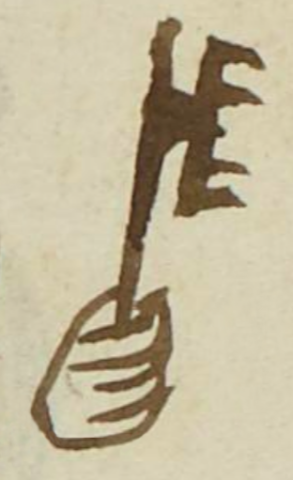Tlatlati (MH508r)
This black-line drawing of the simplex glyph for the noun "key" (tlatlapoloni) doubles as the glyph for the personal name of a man (in this case) who guards things, the tlatlati (and therefore has keys to a special chest, or the like). The glyph shows a human hand with a long, vertical key, about the length of three or more fists, which gives an idea of its proportions. The key has four or five teeth that are on a separate bar attached to the handle.
Stephanie Wood
The key was a European introduction. Officers of the town council in Nahua communities would have keys to the chest or treasury of the town that was used to store tribute collections. These chests often had three keys, and all three people had to be present to open the chest, which was a type of security. Juan José Batalla Rosado (2018, 94) notes that the mayordomo (an officer of the Indigenous town council) would be a key holder. Batalla also found a glyph for the name Pedro, noting how the key was a symbol of Saint Peter, who was the guardian of the doors to heaven. The gloss on Tlatlati shows a final "n" at the end of the name (or occupation), which seems intrusive, so we have left it out.
Stephanie Wood
Juan
tlatlatin
Juan Tlatlati
Stephanie Wood
1560
Jeff Haskett-Wood
llaves, keys, guards, guardianes

tlatlati, to hide something, https://nahuatl.wired-humanities.org/content/tlatlati
tlatlapoloni, a key, https://nahuatl.wired-humanities.org/content/tlatlapoloni
El Guardián
Matrícula de Huexotzinco, folio 508r, World Digital Library, https://www.loc.gov/resource/gdcwdl.wdl_15282/?sp=95&st=image
This manuscript is hosted by the Library of Congress and the World Digital Library; used here with the Creative Commons, “Attribution-NonCommercial-ShareAlike 3.0 License” (CC-BY-NC-SAq 3.0).


